Call center compliance refers to the application of legal regulations and internal standards across all customer service operations. It governs agent-customer interactions, data processing, and protection of sensitive information. This ensures that every customer interaction is aligned with regional laws including the General Data Protection Regulation (GDPR), Payment Card Industry Data Security Standard (PCI-DSS), and the Health Insurance Portability and Accountability Act (HIPAA).
Non-compliance results in financial penalties, legal action, operational disruption, and reputational harm. To prevent such risks, organizations must implement structured, repeatable, and verifiable processes.
This article defines call center compliance and provides 11 standardized methods to strengthen compliance programs. These include structured training, documented protocols, access control, audit practices, and automation. Each method is designed to support legal compliance and operational enforcement.
By following this guide, businesses can reduce compliance violations, sustain regulatory adherence, and protect long-term operational continuity.
What This Article Will Cover
- Staff training and regular refreshers
- Real-time call monitoring
- Documented SOPs
- Secure data handling
- Role-based access control
- Internal audits and remediation
- Approved call scripts
- Consent collection and tracking
- Alerts and incident logs
- Legal documentation
- Automation tools for compliance
Let’s start by exploring how call center compliance functions within an organization and aligns with regulations.
1. Define call center compliance and its regulatory scope
Call center compliance applies across every operational function within the organization. It governs how customer data is handled, how calls are recorded, how agents interact, and how protocols are followed.
Every action by customer service teams must align with defined internal policies and applicable legal standards.
This compliance is closely tied to industry regulations such as GDPR (General Data Protection Regulation), PCI-DSS (Payment Card Industry Data Security Standard), and HIPAA (Health Insurance Portability and Accountability Act).
At the same time, it depends on internal protocols such as agent scripts, call disclosures, and customer verification steps.
For example, agents must ask for explicit consent before recording calls. Customer information must be stored securely with encryption and restricted access.
Agent conduct must avoid using misleading language, engaging in aggressive upselling, or making unapproved statements. Together, these elements define the scope of compliance within a call center and set the foundation for operational integrity.
2. Clarify the Business Risks Associated with Non-Compliance
Non-compliance exposes call centers to serious legal, financial, and reputational risks. Violations may result in substantial fines, lawsuits, or regulatory restrictions. Loss of customer trust can impact long-term brand loyalty and business sustainability. Even small mistakes like recording a call without consent or mishandling customer data can trigger audits or penalties. One undocumented disclosure or missed verification step may lead to a compliance breach.
For example, in 2021, a U.K.-based contact center was fined £4.5 million for unlawfully marketing to consumers without their consent, violating the Privacy and Electronic Communications Regulations (PECR).
In another case, an Australian telecommunications company was fined AUD 10 million for breaching the Australian Privacy Principles by failing to adequately protect customer data, leading to a significant data breach.
3. Identify the Major Compliance Regulations Impacting Contact Centers
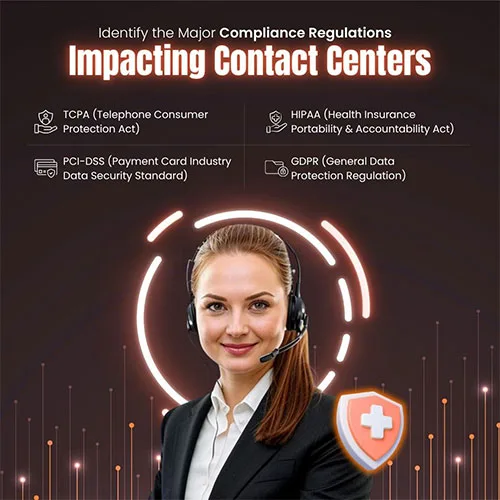
Call centers must comply with several major regulatory frameworks depending on their industry, region, and services.
a) TCPA (Telephone Consumer Protection Act) applies to all U.S.-based contact centers.
It restricts telemarketing calls, auto-dialing, and requires prior customer consent for certain outreach activities.
b) HIPAA (Health Insurance Portability and Accountability Act) affects healthcare-related call centers in the United States.
It mandates secure handling, storage, and sharing of personal health information (PHI) during calls or record management.
c)PCI-DSS (Payment Card Industry Data Security Standard) applies to centers that handle credit card payments.
It requires encryption, restricted access, and secure systems for storing or transmitting cardholder data.
d)GDPR (General Data Protection Regulation) governs data handling for call centers operating in the European Union.
It requires clear consent collection, data minimization, secure storage, and customer rights to access or erase data. Other regional laws may also apply based on the operating country or customer base. For example, India's DPDP Act or Canada’s PIPEDA set similar data protection standards. Each regulation defines specific obligations, and failure to comply may result in severe legal or financial consequences.
4. Establish a Clear Call Center Compliance Checklist
A well-defined compliance checklist helps call centers maintain consistent standards during every customer interaction.
This list should cover all critical areas of customer data, communication protocols, and operational controls.
Essential Checklist Items
- Use pre-approved agent scripts aligned with legal disclosure requirements
- Collect and document customer consent before recording any call
- Restrict data access using role-based permissions
- Store call recordings and customer data in encrypted systems
- Provide a call recording notification at the beginning of each call
- Implement identity verification before disclosing sensitive information
- Define a data retention period based on industry rules
- Maintain audit trails for agent activity and system access
- Review and update scripts regularly for compliance accuracy
- Ensure agents can access updated compliance guidelines during live calls
Compliance requirements differ across industries.
- Healthcare call centers must follow HIPAA to protect patient health data.
- Financial services must meet PCI-DSS standards for secure payment processing.
- Telecom operations must adhere to TCPA and regional communication laws for consent tracking.
- E-commerce support teams must manage customer data privacy and order-related disclosures.
- Insurance call centers follow sector-specific disclosure and claims handling regulations.
Government helplines must ensure strict adherence to public data protection laws and transparency protocols.
5. Address Common Compliance Gaps and Operational Challenges
Many call centers face recurring issues that weaken compliance performance.
These gaps often arise from unclear processes, lack of oversight, or inconsistent training.
Common Compliance Gaps and Practical Fixes
|
Gap |
Basic Solution |
|---|---|
|
Unclear or outdated SOPs |
Standardize and update SOPs quarterly with version control |
|
Manual data logging |
Use automated systems for call records, consent, and agent activity logs |
|
Inconsistent compliance training |
Implement mandatory onboarding and 6-month refresher sessions |
|
Lack of real-time call monitoring |
Set up automated monitoring with alert triggers for compliance breaches |
|
Unrestricted data access |
Apply role-based access control to sensitive information |
|
Missing consent documentation |
Integrate consent capture into the agent script and CRM flow |
|
Irregular audit schedules |
Schedule internal audits monthly and assign audit leads per shift |
|
Incomplete policy communication |
Share updates through a secure, accessible internal knowledge base |
These basic solutions improve compliance readiness across daily operations, reduce errors, and support regulatory accountability.
6. Assign Compliance Responsibilities Across Relevant Teams
A successful compliance program requires clear responsibility at every level of the call center.
Each team must understand its role in maintaining compliance, supported by leadership and defined workflows.
Key Roles and Responsibilities
- Chief Compliance Officer (CCO)
Oversees compliance strategy, audits, and policy implementation.
Coordinates with legal, training, and operations heads to align all practices. - Legal Team
Interprets laws, updates internal policies, and responds to regulatory changes.
Ensures documentation meets regional and industry-specific requirements. - Operations Team
Applies compliance controls in day-to-day workflows.
Monitors agent behavior, enforces SOPs, and handles escalations. - Training Department
Designs onboarding and refresher courses.
Ensures all staff are educated on evolving compliance standards. - IT and Security Teams
Manage access control, data encryption, and system audit trails.
Maintain secure platforms for call handling and data storage.
Each role should follow a documented workflow that defines specific responsibilities, escalation paths, and reporting structures. Assigning owners for key compliance functions improves consistency, transparency, and legal accountability.
7. Implement Structured Compliance Training Programs for All Call Center Roles
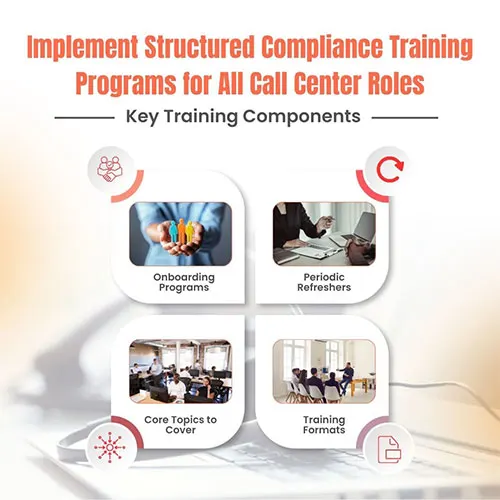
Compliance training is essential for every role in the call center, from agents to supervisors.
It ensures employees understand legal requirements and follow procedures consistently.
Key Training Components
- Onboarding Programs
Every new employee must complete compliance training before handling customer interactions.
It should cover company policies, legal standards, and call handling protocols. - Periodic Refreshers
Conduct training every 6 to 12 months.
Schedule additional sessions after policy changes, audits, or compliance incidents. - Core Topics to Cover
- Data privacy and secure information handling
- Approved script usage and disclosure requirements
- Consent capture and call recording rules
- Identity verification steps
- Role-based data access protocols
- Training Formats
- LMS (Learning Management System) modules with assessments
- Live workshops or webinars led by compliance trainers
- Role-play simulations for real-time scenarios
- Quick-reference guides and digital job aids
Structured training strengthens compliance at the ground level and helps prevent errors during live calls.
8. Monitor Compliance Activities Through Audits and Real-Time Systems
Active monitoring helps detect compliance issues before they escalate into legal or reputational problems.
Both real-time tools and scheduled audits are necessary to maintain consistent adherence.
Monitoring Methods
- Real-Time Call Review
Use monitoring tools to evaluate live calls for compliance breaches.
Supervisors can intervene instantly if violations occur. - Automated Logging Systems
Capture consent records, call durations, data access, and agent actions.
These logs support audit readiness and incident investigations. - Audit Dashboards
Visualize compliance trends, flag irregularities, and assign remediation tasks.
Ensure dashboards are updated in real time.
Audit Best Practices
- Conduct internal audits at least once per month.
- Include random call samples, agent behavior checks, and data access reviews.
- Document all findings with timestamps, agents involved, and actions taken.
- Follow up with corrective measures within a defined timeframe.
- Schedule additional audits after compliance incidents or system updates.
Continuous monitoring builds accountability and ensures that compliance isn’t left to chance.
9. Leverage Technology to Automate and Standardize Compliance Processes
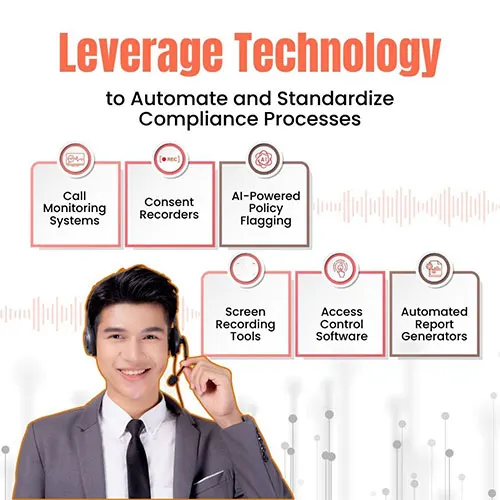
Automation reduces human error and ensures consistent compliance across all customer interactions.
It also saves time and simplifies auditing.
Key Technologies for Compliance
- Call Monitoring Systems
Automatically track, record, and flag non-compliant calls for supervisor review. - Consent Recorders
Log verbal or digital customer consent directly into the call record system. - AI-Powered Policy Flagging
Detects policy violations in real time, such as missed disclosures or incorrect scripts. - Screen Recording Tools
Capture agent activity during calls to ensure proper data access and script usage. - Access Control Software
Restricts data visibility based on role, preventing unauthorized access to sensitive information. - Automated Report Generators
Create audit-ready summaries from logs and call data within seconds.
These tools should integrate with your existing CRM and support platforms.
This ensures that compliance checks happen seamlessly during regular operations.
10. Document and Communicate Compliance Protocols Clearly
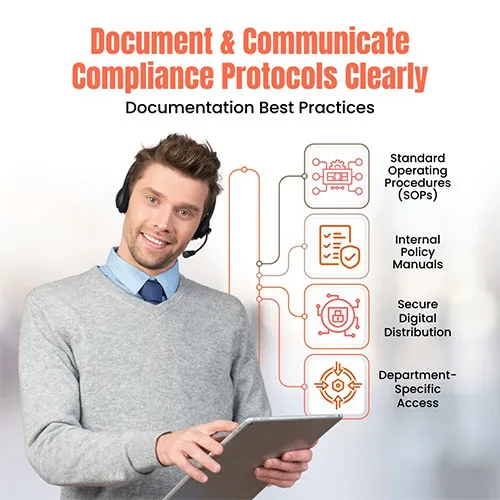
Written compliance protocols ensure every team follows the same legal and operational standards. They reduce confusion, support audits, and improve employee accountability.
Documentation Best Practices
- Standard Operating Procedures (SOPs)
Outline rules for consent handling, call scripts, data storage, and agent conduct.
Use version control to track updates over time. - Internal Policy Manuals
Include all relevant laws, company standards, and consequences for violations.
Make these documents mandatory reading for new and existing employees. - Secure Digital Distribution
Share documents through password-protected intranet portals or compliance dashboards.
Prevent edits by unauthorized users. - Department-Specific Access
Give legal, HR, training, and operations teams appropriate access to relevant sections.
Ensure agents can access current scripts and workflow instructions during live calls.
Clear documentation builds a foundation for long-term compliance and minimizes the risk of policy misinterpretation.
11. Promote a Culture of Continuous Compliance and Improvement
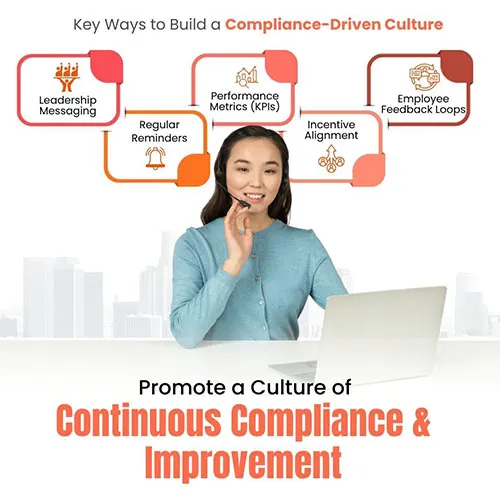
Compliance must be treated as a daily responsibility shared by every employee—not a one-time checkbox.
Sustained efforts lead to stronger legal protection and better customer experiences.
Key Ways to Build a Compliance-Driven Culture
- Leadership Messaging
Executives and managers should regularly reinforce compliance expectations through internal communications and team meetings. - Regular Reminders
Use banners, dashboard alerts, and monthly emails to keep compliance rules top-of-mind. - Performance Metrics (KPIs)
Track compliance performance using metrics like call audit scores, consent accuracy, and policy adherence rates. - Incentive Alignment
Reward teams or individuals who consistently follow compliance protocols through recognition programs or score-based incentives. - Employee Feedback Loops
Allow agents to suggest improvements to compliance processes or report gaps anonymously.
A culture of compliance encourages proactive behavior, reduces violations, and supports long-term operational success.
What Else Should Businesses Understand About Call Center Compliance
Call center compliance covers more than daily procedures and legal checklists. The following FAQs answer common questions about operational roles, training schedules, technologies, and customer impact
What is the Role of a Chief Compliance Officer in a Call Center?
A Chief Compliance Officer (CCO) leads the enforcement of internal and external policy standards. Key duties include managing internal audits, analyzing regulatory risks, ensuring incident response readiness, and coordinating training content. The CCO reports to senior leadership and collaborates with legal, HR, IT, and operations departments to align compliance goals with enterprise strategy. This centralized oversight enables the call center to maintain continuous legal alignment and adapt policies swiftly to regulatory shifts.
How Often Should Call Center Compliance Training Be Refreshed?
Compliance training must begin during onboarding and repeat at regular intervals typically every 6 to 12 months. Training frequency may be higher in highly regulated sectors like finance or healthcare. Update triggers include the introduction of new regulations, internal policy revisions, deployment of new technologies, or the occurrence of a compliance incident. These triggers should prompt immediate refresher sessions across affected teams to minimize the risk of policy violations.
What Technologies Assist in Maintaining Compliance Accuracy?
Core compliance technologies include call transcription software, auto-redaction tools, and real-time policy flagging systems. These tools detect non-compliant language, remove sensitive information from call logs, and document customer consent. Integration with ticketing systems and CRMs ensures that policy enforcement is embedded directly into daily workflows. For example, consent capture can be recorded in the same interface agents use for customer tickets, improving auditability and workflow efficiency.
How Does a Strong Compliance Program Influence Customer Trust?
A strong compliance program builds trust by making interactions secure, consistent, and transparent. Script-based disclosures and identity verification steps show that customer data is handled responsibly. For example, call recording disclaimers and secure authentication reassure customers that their privacy is protected. These visible practices increase confidence, improve satisfaction, and support long-term loyalty.
Conclusion
Call center compliance is an ongoing responsibility that spans teams, technologies, and operational workflows. This article outlined actionable steps to strengthen compliance, reduce risk, and align with evolving industry regulations. Businesses that embed these practices into their daily operations protect both customer trust and long-term operational integrity.







